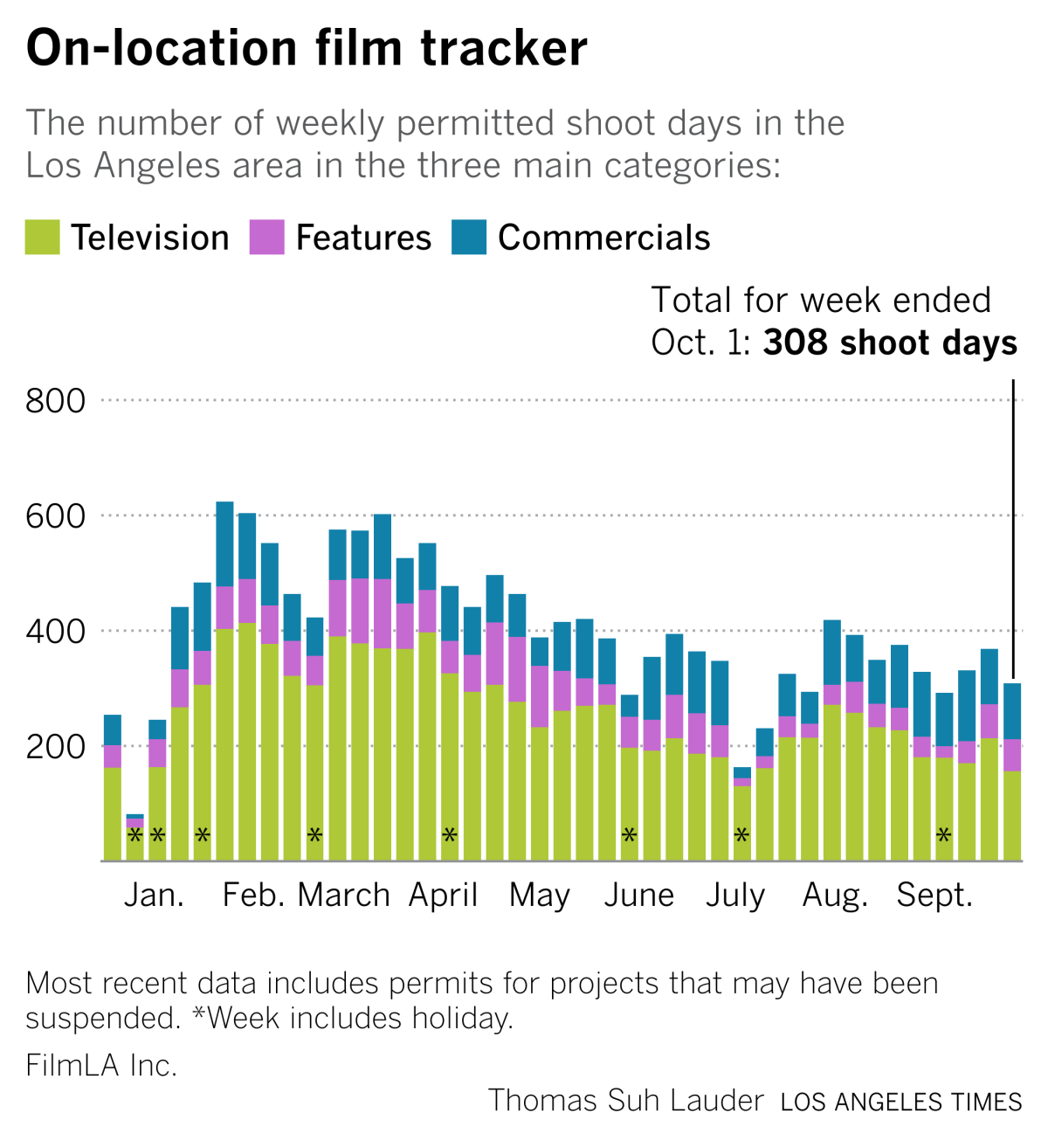After the WGA declares victory, what will SAG-AFTRA win from the studios?

- Share via
Welcome to the Wide Shot, a newsletter about the business of entertainment. Sign up here to get it in your inbox.
Amid the sighs of relief and celebratory atmosphere that accompanied the end of the 148-day writers’ strike, it was hardly a surprise to see the Hollywood studios quickly reengage in talks with SAG-AFTRA, which represents 160,000 (still striking) performers.
The sides met Monday in hopes of ending the actors’ strike, which started in mid-July and lent a surge of energy to their Writers Guild of America counterparts, who have promised to return the favor of their support even as the scribes are called back to work.
Going into this week, there was some expectation that SAG-AFTRA’s dealings with the Alliance of Motion Picture and Television Producers should wrap up relatively quickly, given that the writers were able to secure a tentative agreement in five days once the studios’ chief executives engaged. The rhetoric has cooled off. Expectations are high. SAG-AFTRA and the AMPTP plan to meet again Wednesday.
But reaching a truce is not quite as simple as using the Writers Guild of America’s memorandum of agreement as a template for the actors, though there is some overlap on the major issues.
SAG-AFTRA represents a diverse group of performers, including stunt performers, singers, dancers and background actors, who each have their own demands to address. Representatives for the actors and writers have said they don’t expect this to become a “pattern bargaining” situation, which is when one guild more or less accepts the terms to which another labor group agreed.
“We’re happy WGA came to an agreement, but one size doesn’t fit all,” SAG-AFTRA President Fran Drescher told CNN on Thursday.
Notably, SAG-AFTRA had sought a Year One wage increase of 11% to counteract the squeeze of inflation, followed by smaller bumps in Years Two and Three. The writers accepted yearly wage boosts of 5%, 4% and 3.5% over the three-year contract (their initial proposal was 6%, 5% and 5%, so they came down a little). The actors are looking for specific protections governing the use of self-taped auditions, which increased in prevalence during COVID-19, and greater relocation allowances.
Even in the main areas where there’s overlap, there are meaningful differences between the actors’ and writers’ issues, including those regarding regulation of artificial intelligence.
As my colleague Brian Contreras wrote last week, the threat of generative AI is different for scribes and performers.
For one thing, the technologies that enable AI-created visuals and dubbing, for example, are distinct from text-based programs like ChatGPT. Also, those technologies are already being used by studios in ways that could present more immediate threats to human actors (just ask Tom Hanks), who may have fewer legal protections for the use of their likeness and voice, experts told the Times.
The WGA, throughout the strike, emphasized the variety of constituencies for whom it was advocating. And in the aftermath, it has touted the gains it made for all those groups. For feature screenwriters, the union won a guaranteed second step in their deals so that scribes wouldn’t end up rewriting their movie script without additional compensation. It also achieved better terms for writers working on comedy-variety and quiz shows made for streaming.
Other victories had to do with foreign streaming residuals and premiums for writers working in development rooms lasting fewer than 20 weeks.
The writers guild also declared its triumph on demands that it considered existential for current members and future generations but was previously told were nonstarters. A big one: minimum staffing size and duration of employment to combat studios’ attempts to use fewer writers, working on shorter seasons, to save money on television series.
In writers’ rooms for greenlighted shows, a season of up to six episodes must employ three writers. A season of seven to 12 episodes must have five writers (including three writer-producers), while anything 13 episodes or longer needs six writers. These rules don’t apply if a single writer is hired to write all the episodes of a season on their own.
Staff in development rooms — writers’ rooms convened before a television show is ordered for production — are guaranteed at least 10 consecutive weeks of work, while on greenlighted series, writers are guaranteed at least 20 weeks or the duration of the room, whichever is shorter.
One of the biggest wins for writers was a system for earning bonuses based on viewership for streaming shows. Series and movies are eligible for the reward if they are viewed by at least 20% of the service’s domestic subscribers during the first 90 days of release. That’s a high bar but not as stratospheric as it might sound.
For one thing, the WGA and the streamers are using domestic “views” as their metric, rather than unique accounts that watched a particular show. Views of a season or movie are determined by dividing the total hours streamed by the total run time.
Think about it this way. Netflix has roughly 75 million subscribers in the U.S. and Canada, meaning that a show would have to achieve about 15 million domestic views to earn the bonus.
Take a look at the viewership data in Netflix’s weekly Top 10 lists. Even though those are calculated on a global basis, it doesn’t seem as if you would need a “Bridgerton”-level smash to get the extra payday. By Netflix’s own calculations, the romance “Love at First Sight” rang up 29 million views worldwide from its first two weeks in release. Obviously, global is different from domestic, but you get the idea. Hitting the 20% mark is appropriately difficult, but it’s not like me trying to win gold at the Olympics.
Despite the limits and loopholes in the WGA deal, the fact that minimum staffing and streaming bonuses are now realities is remarkable considering how far apart the sides were as recently as August. For unions including SAG-AFTRA, which is looking for its own revenue-sharing opportunities in streaming, the writers’ memorandum is a guide for what is now achievable.
Stuff we wrote
— False starts, secret talks: Insiders tell how the writers’ strike ended with ‘Let’s make a deal.’ The 2023 WGA strike lasted 148 days, making it one of the longest work stoppages in Hollywood history. Why did it last so long?
— ‘It was a trauma’: Now that the strike has ended, showrunners wonder how they begin moving forward. Several TV showrunners speak to The Times about the end of the writers’ strike and how sadness and frustration over the negotiations temper their joy.
— Now that writers can work again, here’s when daytime and late-night talk shows will return. The first shows to walk at the start of the Writers Guild of America will be the first to return, with staffs cranking out gags as soon as next week.
— ‘Fortnite’ maker Epic Games cuts 16% of staff after ‘spending way more money than we earn.’ Epic Games, the video game developer behind the popular online game “Fortnite,” is laying off 830 employees, the company announced Thursday. The company also is divesting Bandcamp.
— Newsom vetoes bill to give striking workers unemployment benefits. California Gov. Gavin Newsom vetoed a bill on Saturday that would allow workers on strike to collect unemployment benefits after being on the picket line for two weeks.
Film shoots
With the actors’ strike still in full effect, film and television production was still depressed as of last week.

Best of the web
— It’s not just you; LinkedIn has gotten really weird, according to a publication that would know.
— Rupert Murdoch’s unfinished business. (Bloomberg)
— Mary McNamara: We are never, ever, ever... going back to normal.
— “What should I watch?” is now a much easier question than “How do I watch it,” writes Charlie Warzel. (The Atlantic)
— The scientific reason you can’t stop going to Disneyland.
Finally ...
I recently teased the new reissue of “Tim,” the 1985 album from Midwest rock ’n’ roll miscreants the Replacements. Producer/audio engineer Ed Stasium’s mix totally de-’80s-ifies some of the band’s best songs. Guess what — it rules.
Also, to celebrate the release of “Stop Making Sense,” Jonathan Demme’s landmark concert film of Talking Heads, here’s the Los Angeles Times’ interview with the band.
Lastly, this one is just for me, but Living Colour shredder Vernon Reid has been on a tear on Twitter/X lately, trying to draw more attention to underappreciated guitar gods such as Ernie Isley and Mike Stern.
The Wide Shot is going to Sundance!
We’re sending daily dispatches from Park City throughout the festival’s first weekend. Sign up here for all things Sundance, plus a regular diet of news, analysis and insights on the business of Hollywood, from streaming wars to production.
You may occasionally receive promotional content from the Los Angeles Times.




